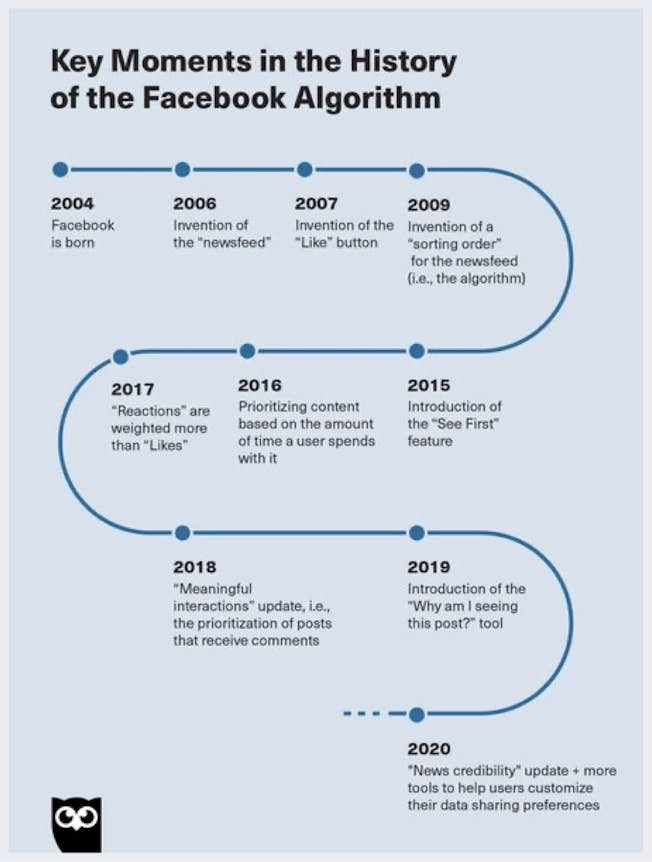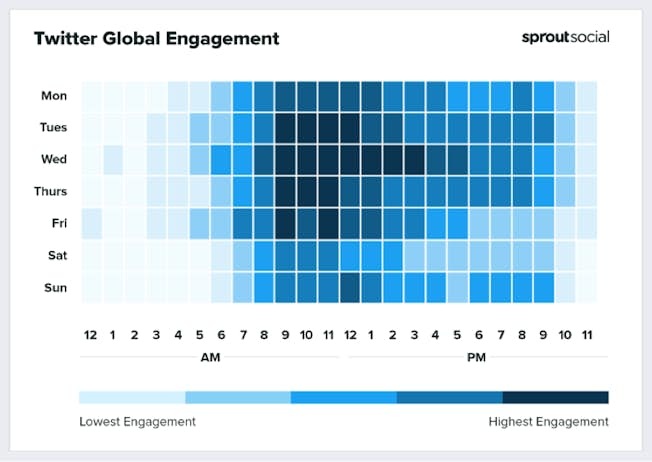Social media is so ingrained in our culture that it’s now a daily activity for the majority of people across the globe. And it’s not only the established networks that are gaining users every day; new platforms such as TikTok and Twitch are attracting brands who want to advertise to engage new audiences.
In 2021, according to SimilarWeb, YouTube and Facebook are the second and third world’s most visited websites after Google. That’s pretty impressive for networks that are only 16 and 17 years of age!
With so many users on these platforms, there's a need to create order and relevancy, and an algorithm does just that.
Social media algorithms are always changing, making it difficult for marketers to keep up. There’s no way to know every detail that goes into each change, but we have a good idea. The algorithm in play dictates where you rank in social media ads and content placement on a user’s feed.
In this guide, you'll find out what an algorithm is, the different social media algorithms, and how to optimize your content distribution and engagement for social media.
What Are Social Media Algorithms?
An algorithm is a mathematical set of rules specifying how a group of data behaves. In social media, algorithms help maintain order and assist in ranking search results and advertisements. On Facebook, for example, there is an algorithm that directs pages and content to display in a certain order. (There are some great Facebook algorithm engagement hacks you can use if you’re looking to attract more views.)
As of October 2021, there were approximately 4.5 billion internet users, and of these users, about 57 percent of the world’s population use social media. That’s a massive undertaking to monitor and manage. This is why algorithms are so crucial in determining the validity and placement of social media accounts and content.
While there’s no handbook on the many algorithms and how to maintain them, we know enough to maneuver the social media landscape and succeed. One of the major shifts in the past few years has been a user-friendly focus, much like the one Google ranks by. This encourages social media users to submit relevant, high-quality content, and engage with consumers.
Why Do Social Algorithms Exist & Why Do They Change?
Algorithms are used on social media to sort content in a user’s feed. With so much content available, it’s a way for social networks to prioritize content they think a user will like based on a number of factors.
As a marketer that may sound wonderful as it gets your content in front of the right people. But be warned, social media algorithms are by no means perfect.
The purpose of an algorithm is to filter out irrelevant content or content that’s not high quality. This puts your content at risk of being buried or hidden from feeds if it does not fit the criteria. Plus, as Google introduces a new ranking signal into the mix - page experience - it’s key that you brief yourself on core web vitals to ensure your content gets seen by bots and users.
An analysis of YouTube found that videos got millions of views even though they were not relevant to the user, but were chosen by the algorithm. In fact, the same study found that 64 percent of users came across YouTube videos that seemed false or untrue, while 60 percent encountered videos with people taking part in dangerous or troubling behavior
As a fallible system, social networks regularly tweak their algorithms to improve user experience. The solution? Ensure your content is high quality, relevant and appealing while keeping an eye on any algorithm changes to see if you need to tweak your social media strategy.
Types of Social Media Algorithms
Social media algorithms vary by platform. Therefore, you can break it down by social media brand. The main platforms are Facebook, Pinterest, LinkedIn, Twitter, and Instagram. Here’s a look at each and how they currently rank content and users.
Facebook Algorithm Explained
Meaningful customer engagement is the key to Facebook's algorithm layout. It's created to intensify the importance and viewership of local, familial and friendly posts, rather than business posts. It’s made up of four ranking signals:
- Popularity
- Content type
- Relationship
- Recency
There have been many changes in Facebook’s algorithm over the years that make it difficult to get posts, particularly organic ones under the right eyeballs without planning and strategy.

Organic reach on social networks is on the decline. On Facebook, that means that the average reach for an organic post is down over 5 percent while the engagement rate is just 0.25 percent which drops to 0.08 percent if you have over 100k followers.
Paid Facebook content is ranked separately but still revolves around engagement, customer response, and relevance to the subject matter. Key tips to working with the Facebook algorithm include:
- Building connections is key to ensure your brand replies to comments or queries
- Look to encourage a response that’s stronger than just a ‘like’ as Facebook puts more weight on reactions buttons
- Use Facebook Stories as they are not in Facebook’s newsfeed and so do not rely on the algorithm to get seen
- Live video gets more engagement and so is favored by the algorithm
- Be careful with external content - make sure it’s credible and not misleading before posting it
Pinterest Algorithm Explained
While Pinterest has a very different layout and follower strategy, it counts as a social media platform, nonetheless. Pinterest’s algorithm is based on four key factors:
- Relevance of topic
- Quality of a Pin
- Domain quality
- Quality of the Pinner
Its guided search method uses data collected from past content interactions to encourage new links. So for example, if you've previously viewed wedding hairstyles, Pinterest is more likely to show you more hairstyles the next time you log in.
The benefit to this interest-themed algorithm is that it’s always showing the user something Pinterest knows they like. Plus, their ‘controllable distribution’ introduced in 2020 means that users get to see a capped number of new content based on what you’ve seen in the past. This makes the content more likely to be consumed and enjoyed.
In 2021 due to the Covid-19 pandemic, people’s searches and intentions changed as they sought out products that share their values. According to Pinterest, this means 3 things for brands:
- Know your values
- Test ads that are grounded in your values, not just your products
- Make it clear how purchasing from you will help customers live and show off their values.
If you’re a brand that creates great visual content using Pinterest may be good for your business.
TikTok Algorithm Explained
TikTok is a social media channel that’s exploding in popularity. TikTok’s personalized algorithm works so well because it categorizes the addictive ‘For You’ feed with videos. But how does it work?
There are a few simple ranking signals for TikTok content which include:
- User interaction
- Video details such as captions and hashtags
- Device and account settings which include country and language
The exciting thing about TikTok is that recommendations are not based on how many followers you have or video success. Ultimately TikTok is a platform that loves good video content so everyone has a chance to get their content seen by users, brands and creators. This makes it a valuable platform for marketers that want to engage a young demographic with clever video content.
LinkedIn Algorithm Explained
Recognized as a leader in B2B marketing, LinkedIn is a social platform dedicated to networking, rather than building followers. It’s currently the most common platform for Fortune 500 company use.
The site has developed an algorithm based on connection and engagement, so strong and relevant content is the key to LinkedIn success. The algorithm aims to promote engagement and prioritize relevant content. Since 2018, LinkedIn’s algorithm has seen a 50 percent increase year on year in viral activity. Even if you don't have a lot of links in your networking chain, you can build this later if you have read-worthy content.
Key tips to tap into LinkedIn’s algorithm include:
- Use between 3 to 10 hashtags in a post
- Video content is more popular than other types but is no longer prioritized in a feed
- Comments are more important than likes or reactions
- Dwell time (how long someone spends watching or reading the post) is important so make your content engaging
- Build your network by engaging with relevant people, get employees to be active on platform or get involved in LinkedIn Groups
- Consider testing out LinkedIn ads to grow your network and audience
- Use analytics to understand what content works
Twitter Algorithm Explained
When Twitter first came out in 2006, it ranked posts according to the timeline and so it was focused on the day and time rather than the content. Today, Twitter’s algorithm is more complicated than that and now relies on relevance rather than solely on time posted.
The main signal for Twitter’s algorithm is:
- Engagement
- Activity
- Recency
- Media type e.g. GIF, photo
Twitter also divides posts into three sections: ‘In Case You Missed It’, algorithm-based posts and reverse chronological order. The key to using Twitter for your business is to post relevant content, be consistent, drive engagement (which includes engaging with comments on your side) and post at optimum days and times.

Instagram Algorithm Explained
Similar to Twitter, Instagram’s algorithm was based on chronology so it prioritized posts by time. In 2021, the algorithm now looks at six key factors: interest, relationship with a user, following, session time, time posted and user session time.
On Instagram, Carousels get three times more engagement than other post types while Reels are currently boosted so people use the new feature. This means your brand shouldn’t be afraid to try new features to grow engagement and get noticed on Instagram.
Become a Successful Digital Marketer (and Algorithm Tracker) with an In-Demand Certification
Whether you’re a social algorithm beginner or expert, DMI’s Social Media Marketing course will teach you how to harness the power of each platform from TikTok to YouTube and Facebook to drive leads, increase sales and improve ROI. You will also understand how to use social media as a customer service channel, understand how to conduct social research and develop a successful social strategy.
Updated 2022
Related
Upgrade to Power Membership to continue
your access to thousands of articles, toolkits, podcasts, lessons and much much more.
Become a Power Member- Login
- View Courses
- - - -
- Courses
- Resources
- - - -
- My Account
- Change Password
- Logout





